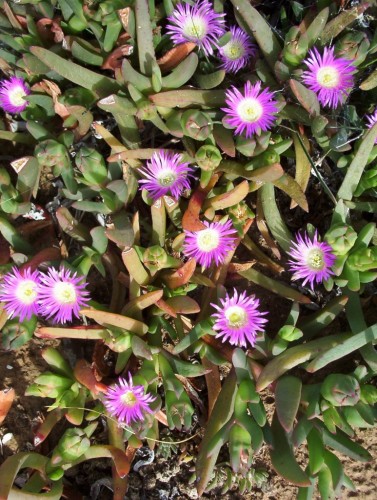Carpobrotus rossii (Pig Face) In Flower
This is the flower of the succulent plant in the previous post. There were only a few isolated flowers on the plants near the nest. This is a useful plant. Not only is it useful and decorative in the garden, it is one of the bush tucker plants used by the local Aboriginal group. The leaves and fruits were used as a kind of relish to be eaten with meat. The juice from the leaves is also said to be an insect repellant. As with any new thing, a cautious test should be done before slathering one’s skin with the juice of an unknown plant.
I guess the same could be said for the plants in the Aloe family. Aloe Vera is good on a number of skin ailments but I am never sure which member of the species is the one to use.
Carpobrotus rossii (Pig Face, Karkalla)
Husband was checking out a pigeon’s nest in the corner of our block when a small bird seemed to fly from under his foot. Closer inspection revealed this little burrow at the base of the pig face, Carpobrotus rossii. The bird is the Spotted Pardalote. These and Rainbow Bee Eaters make burrows in sandy banks or cliff faces. During the spring and summer we often find scratchings that indicate the beginnings of burrows and it is quite exciting to actually have one being constructed on our place. Husband was able to get a photo of the bird carrying grass to the burrow to line it.
The nest is in the middle of the patch of this Pig Face. It is a very hardy plant like all succulents seem to be. I will be planting some of this on the edge of our driveway to create the illusion of ‘lawn’. There is no way that I could keep lawn going there and I wouldn’t want to anyway because it would be a waste of water.
Hardy Ground Covering Plants
I was checking on the garden forum and came across a request for help re growing some Western Australian plants in Newcastle, north of Sydney. The person writing had done his homework and was prepared to create a good mound to provide extra drainage for the plants he wanted to try in the ground. I would have thought he would have had success with what he proposed to do. However someone said that he had not taken into account the humidity of the area. This is something that had not crossed my mind at all.
Here humidity is associated with thunderstorms and changes in weather patterns in the summer. Basically the climate is dry. What I call hardy plants could well turn out to be difficult plants in a humid climate. It certainly pays to think about atmosphere as well as soil conditions and moisture in the overall picture of growing plants. Some plants will adapt when they are grown in the open with good air flow around them, rather that being part of dense undergrowth. Otherwise they are subject to fungal attacks.
I decided to actually make a few lists of plants and then find information about the plants, rather than find then one by one.
Hardy Ground Covering Plants
Brachyscome multifida ‘Amethyst’ (Cut leaf Daisy)
Brachyscome multifida ‘Breako’day’ (Cut Leaf Daisy)
Leucophyta brownii (Cushion Bush)
Calothamnus quadrifidus prostrate form
Chrysocephalum apiculatum (Yellow Buttons)
Correa alba low forms (White Correa)
Correa decumbens (Mt Lofty Correa)
Correa ‘Dusky Bells’
Dampiera diversifolia
Eremophila glabra prostrate, yellow flowers (Emu Bush)
Goodenia varia (Sticky Goodenia)
Grevillea lanigera (Woolly Grevillea)
Grevillea thelemanniana ‘Sea Foam’
Grevillea thelemanniana prostrate forms
Halgania cyanea (Mallee Blue-Bush)
Myoporum parvifolium (Creeping Myoporum)
Rhagodia spinescens (Hedge Saltbush)
Scaevola aemula (Fan Flower)
Scaevola ‘Mauve Clusters’ (Fan Flower)
Related Articles
- Twenty Drought Tolerant Plants here.
- Frost Hardy Plants here.
- Hardy Eremophilas here

